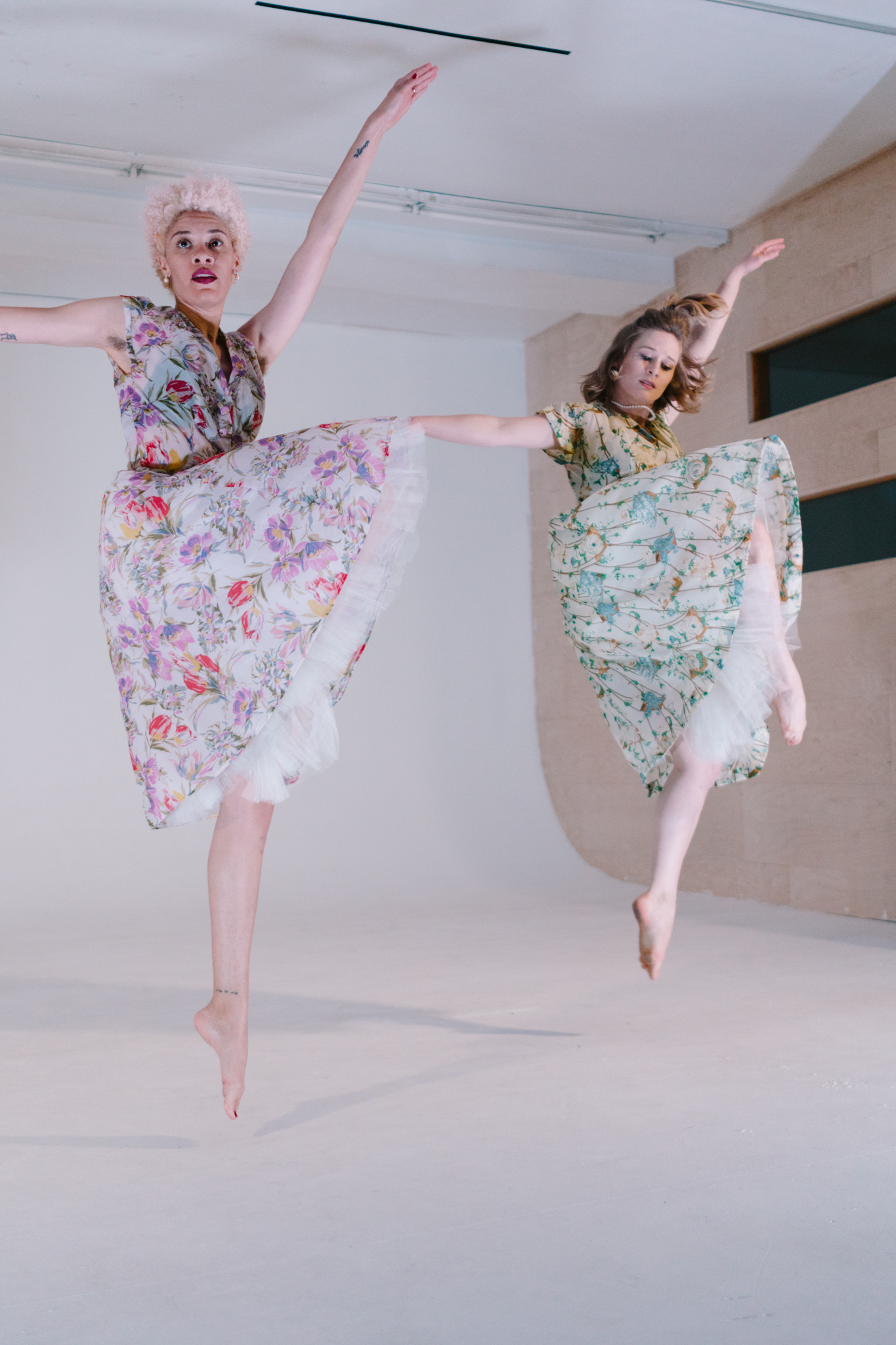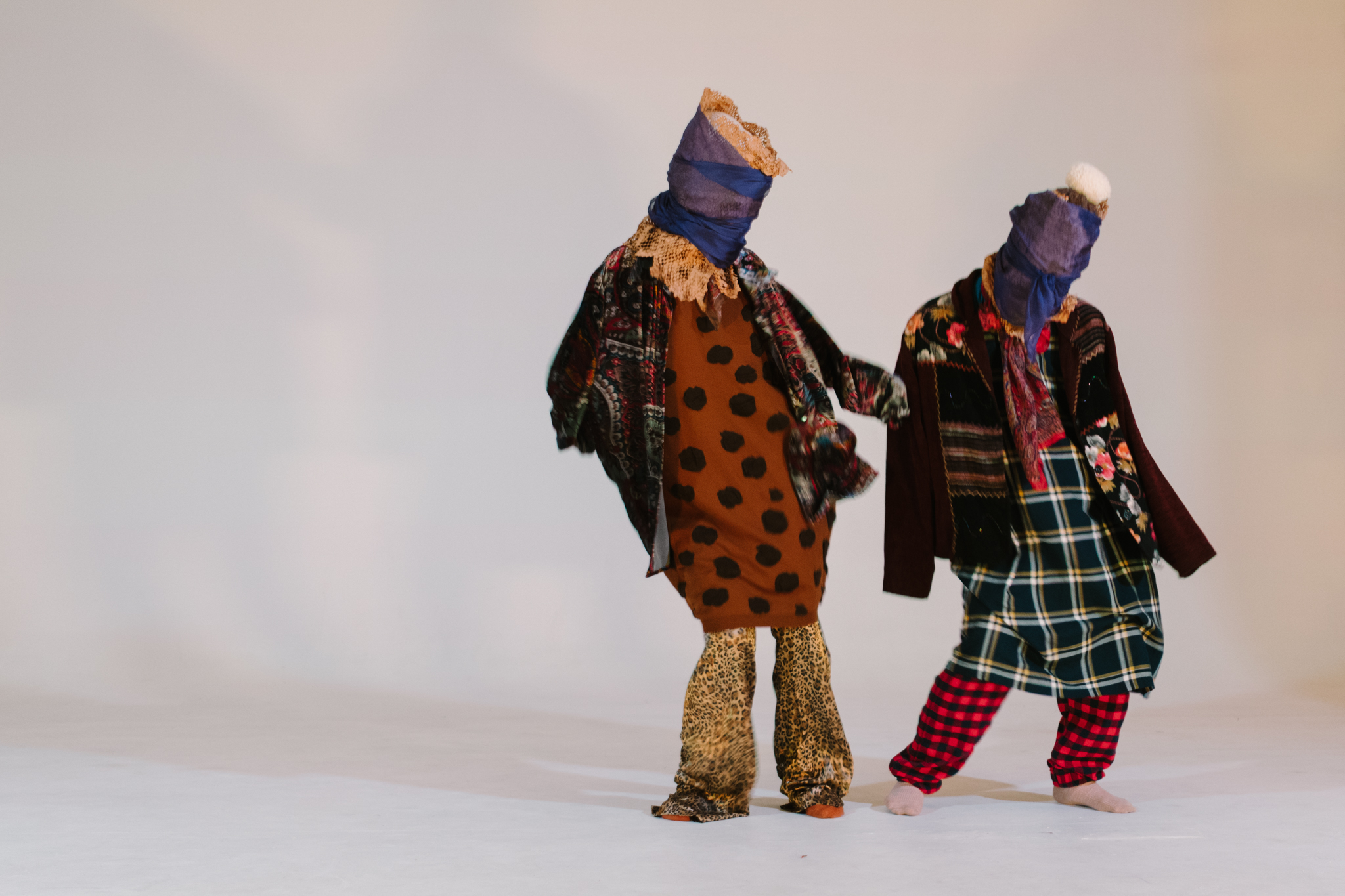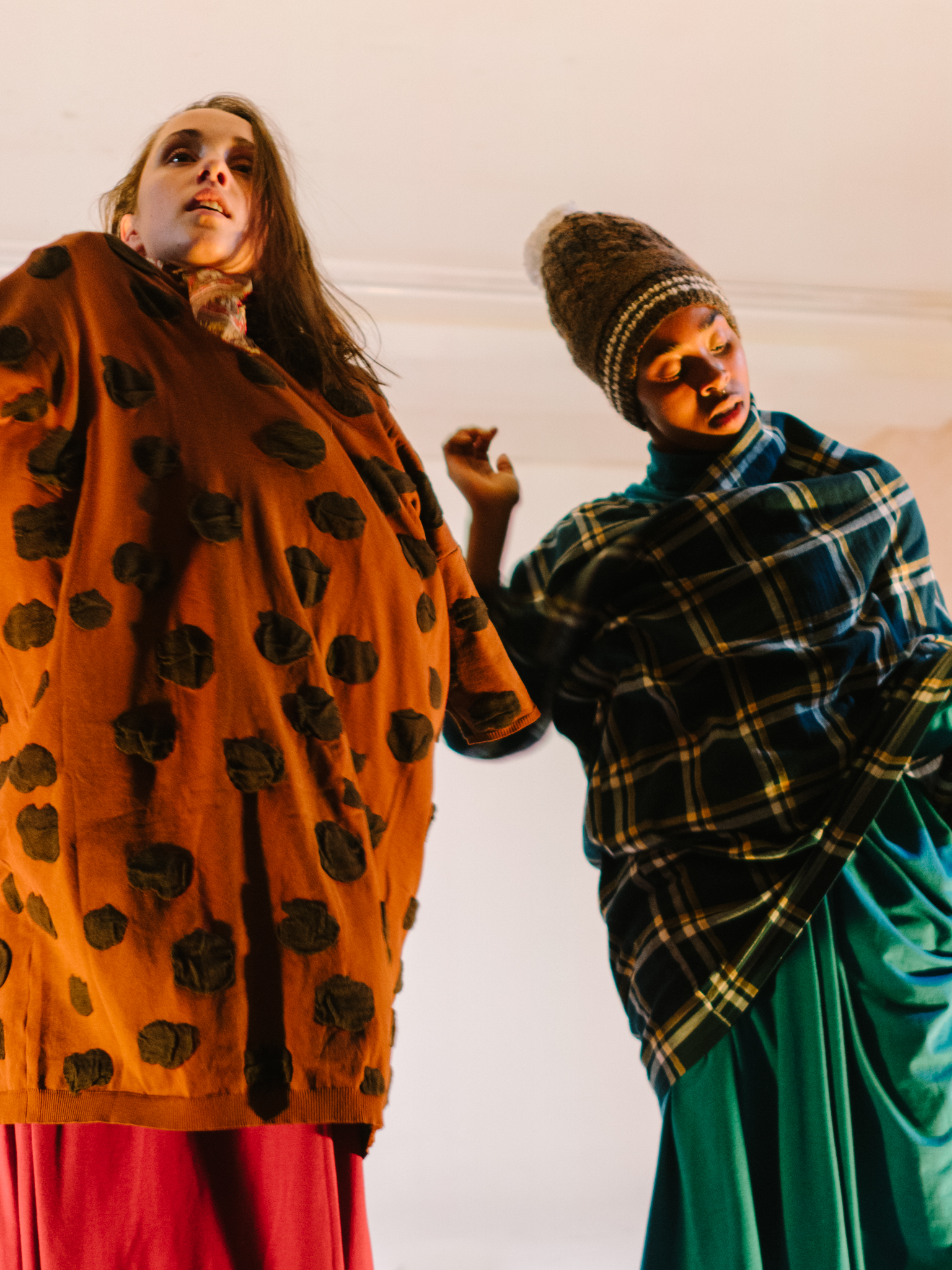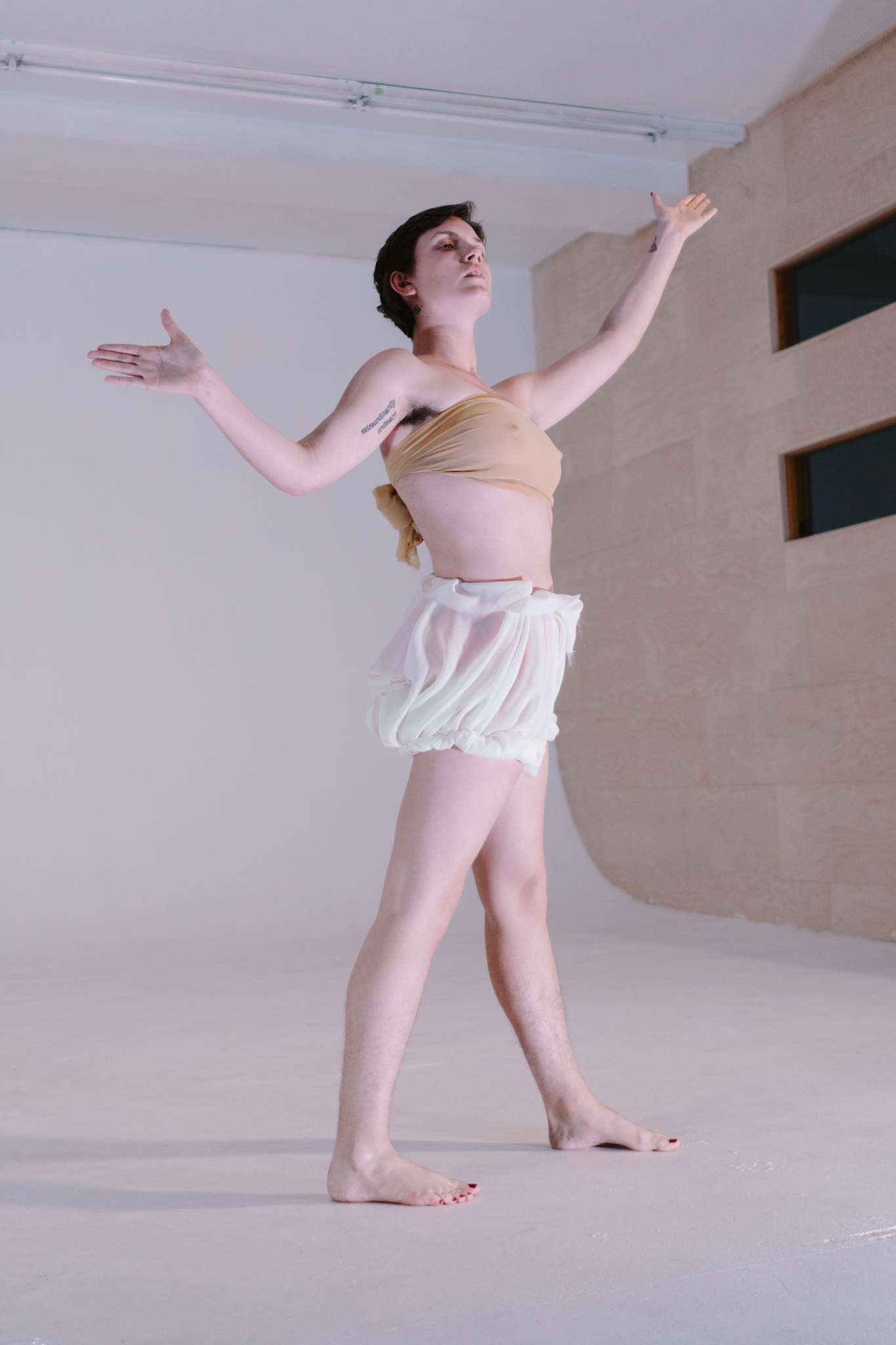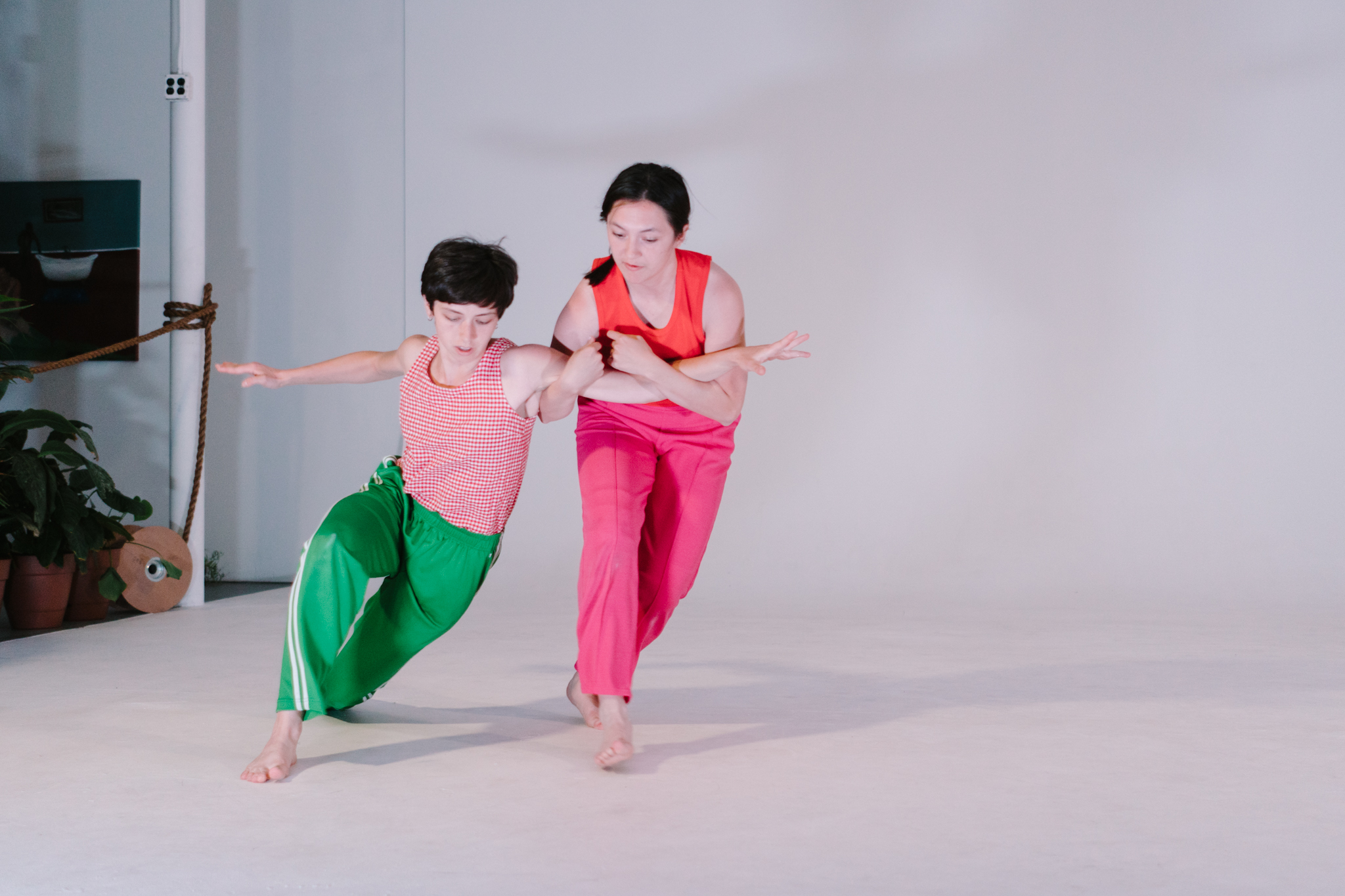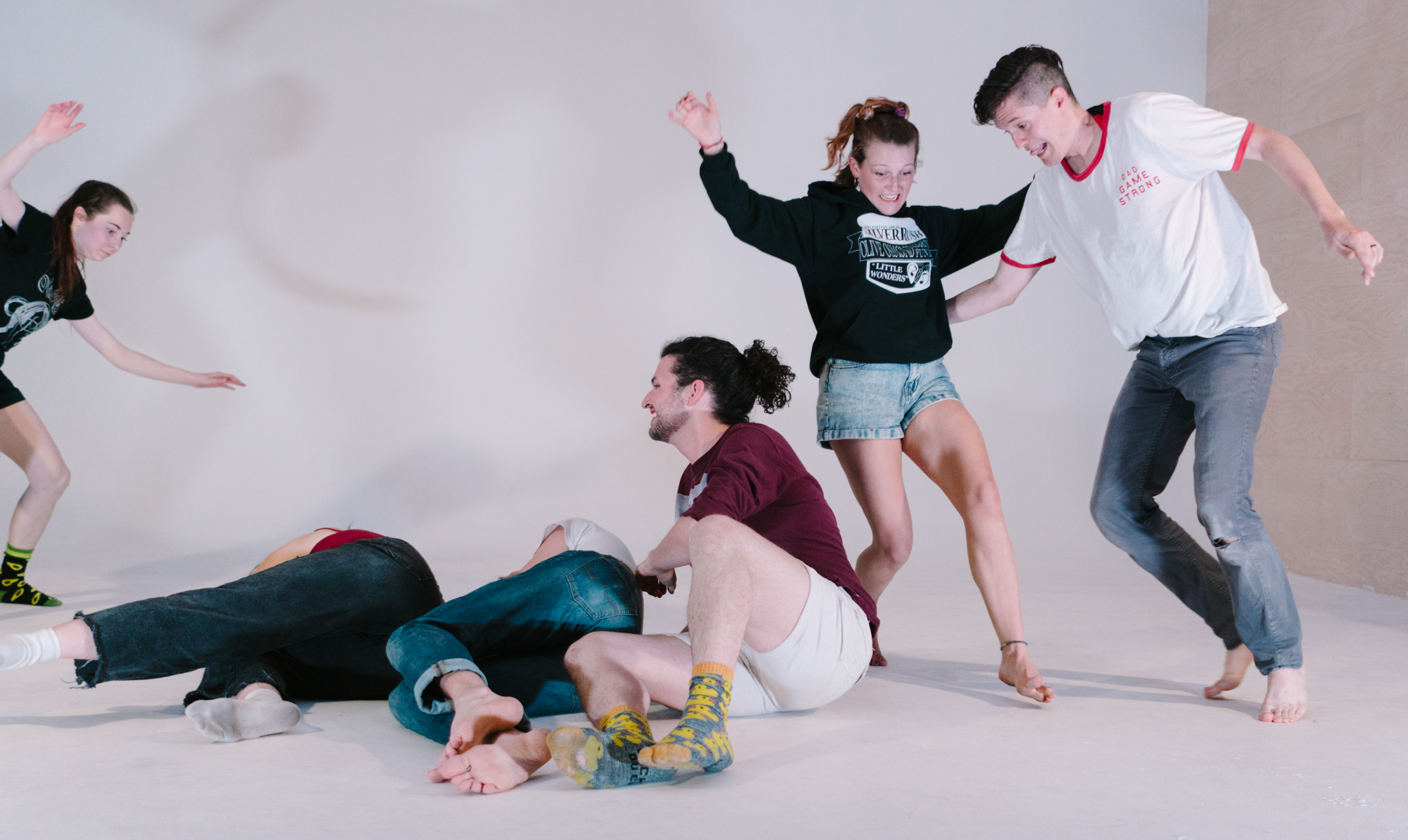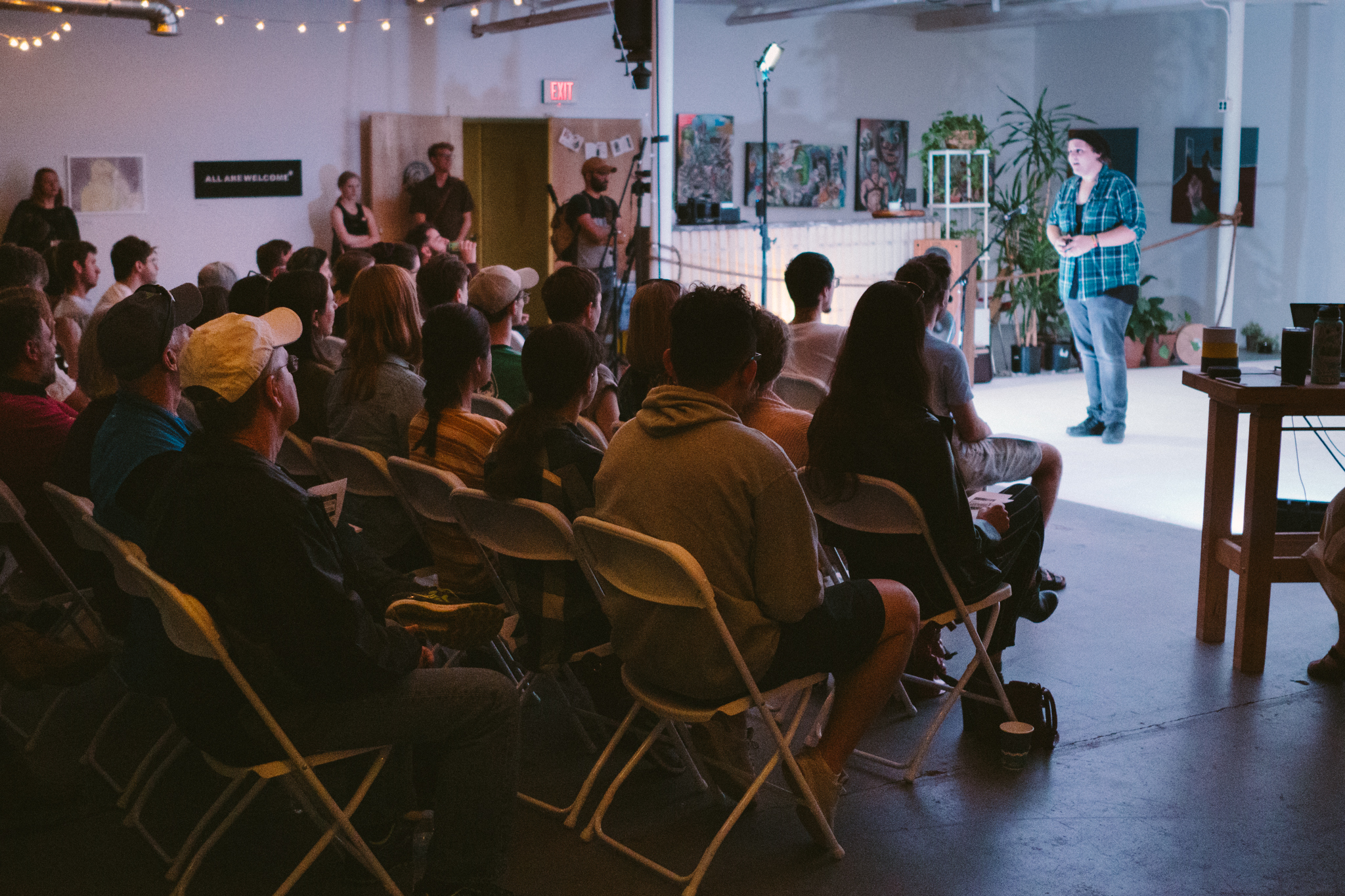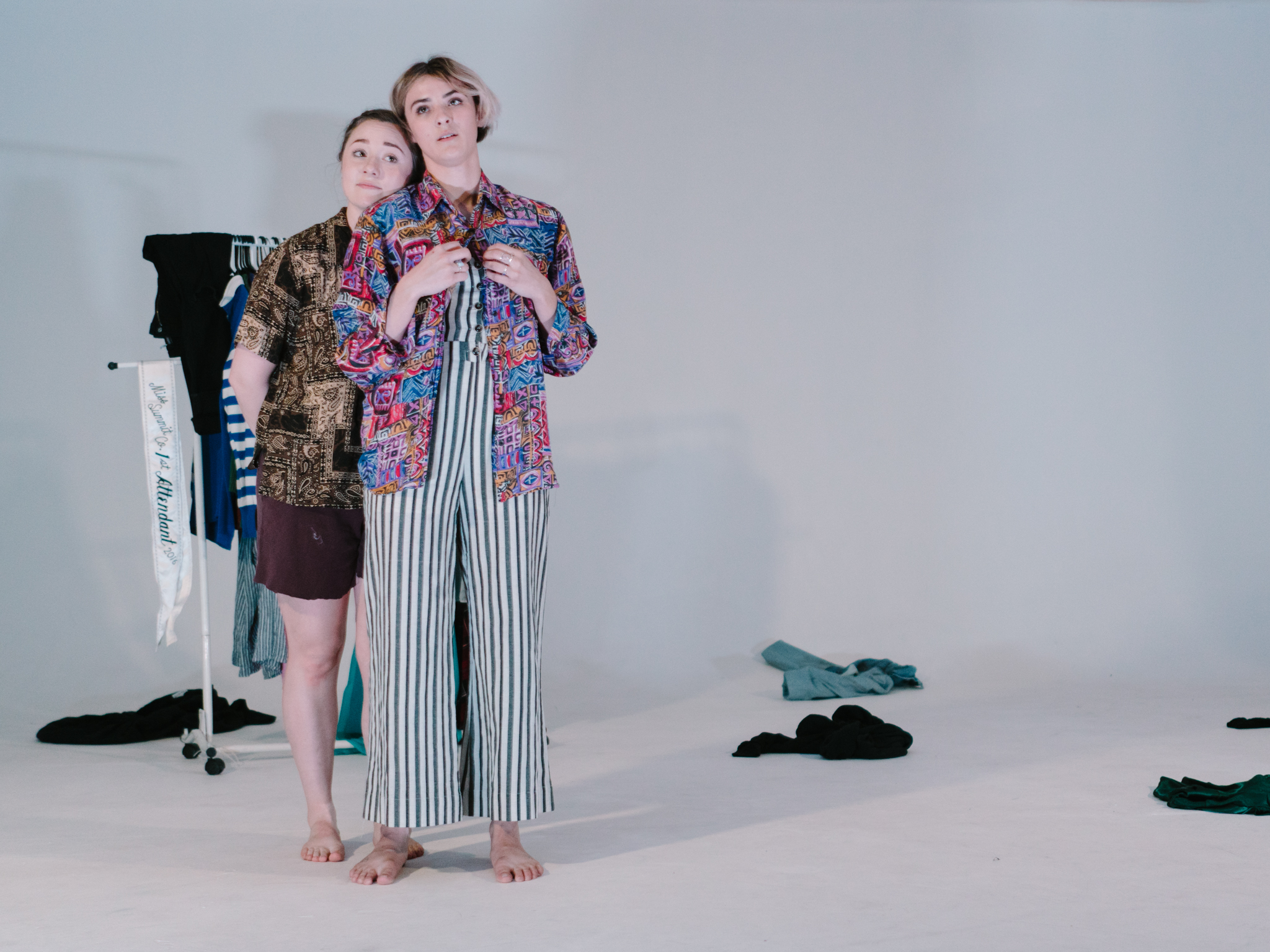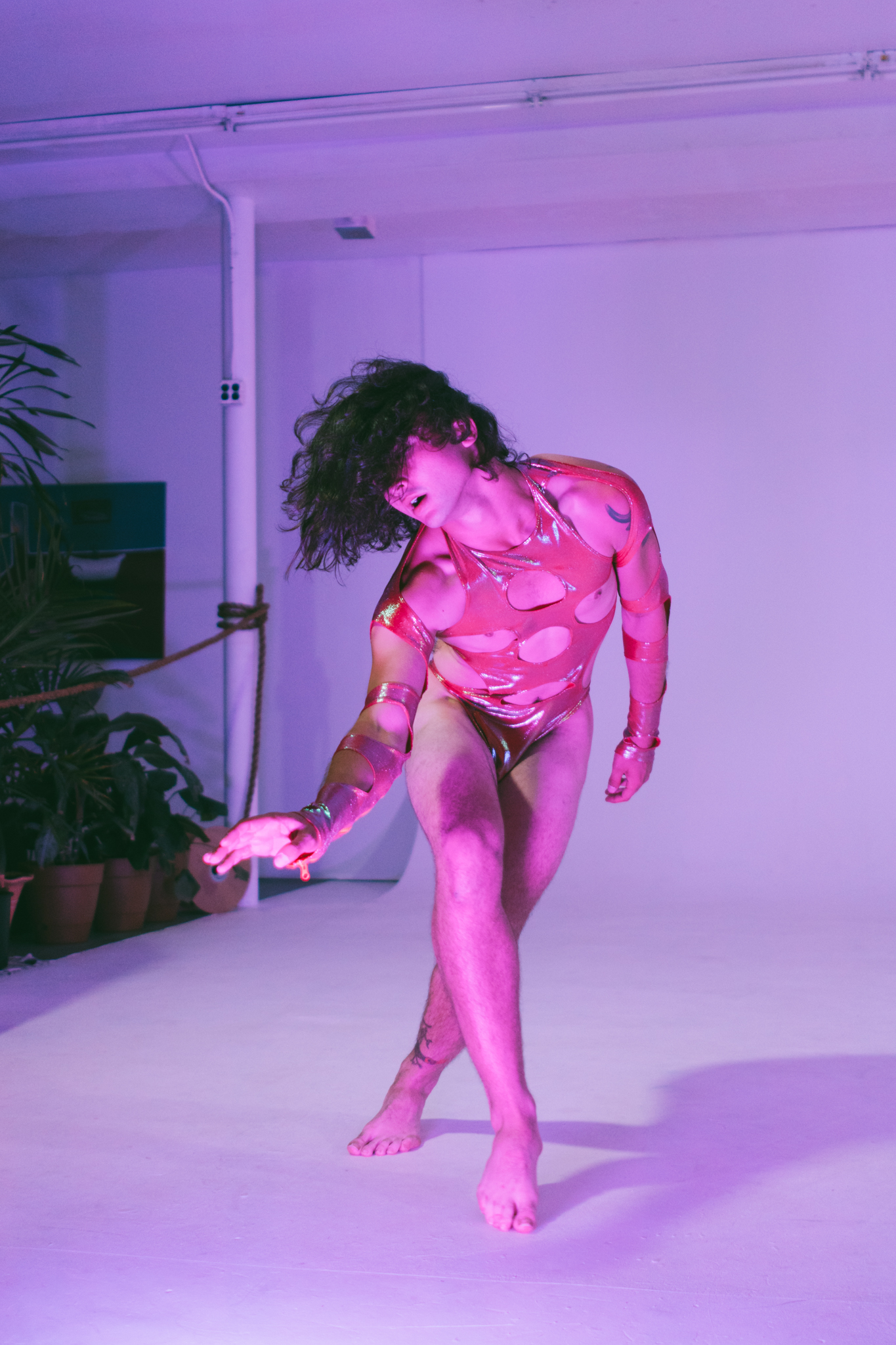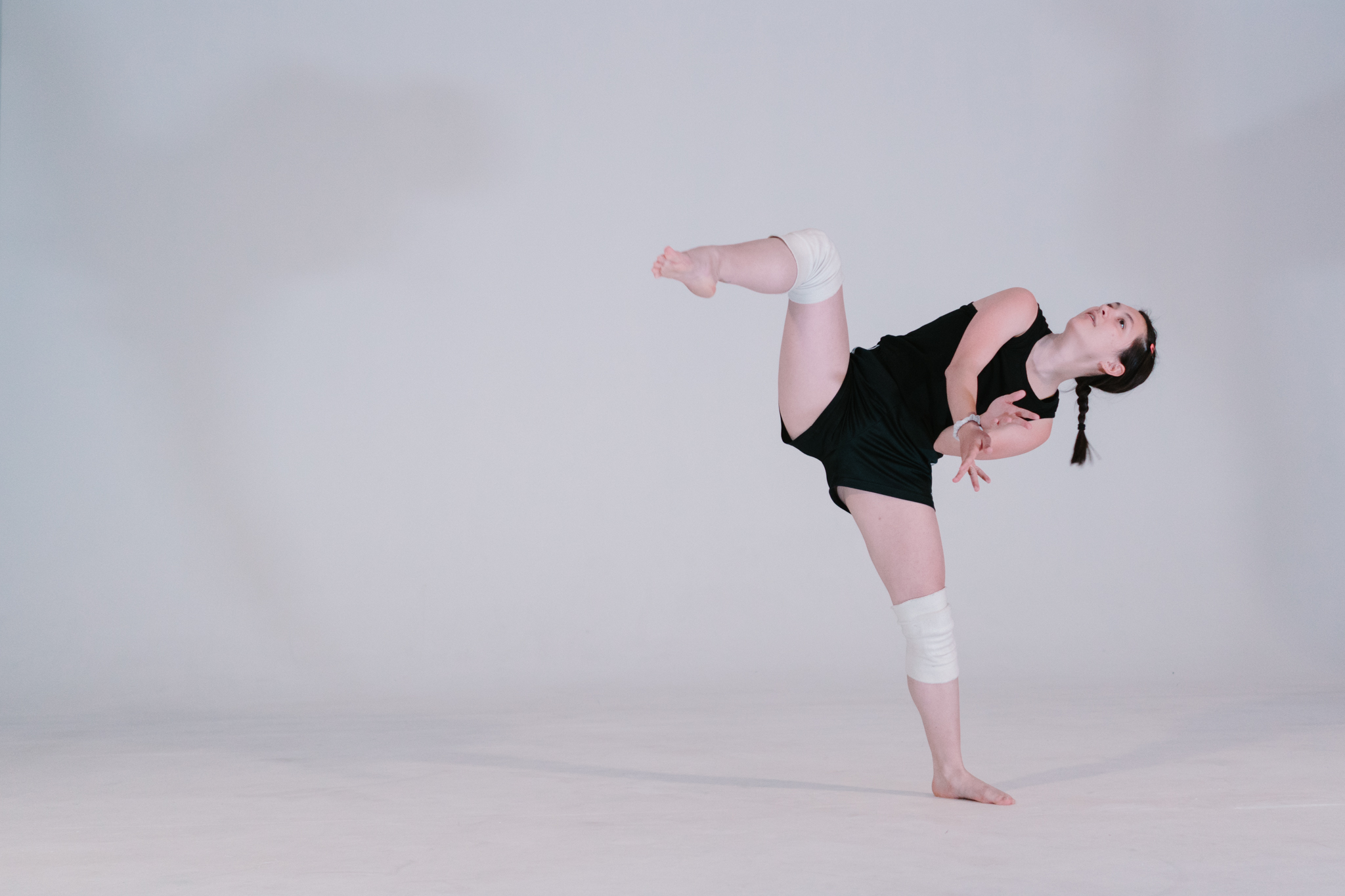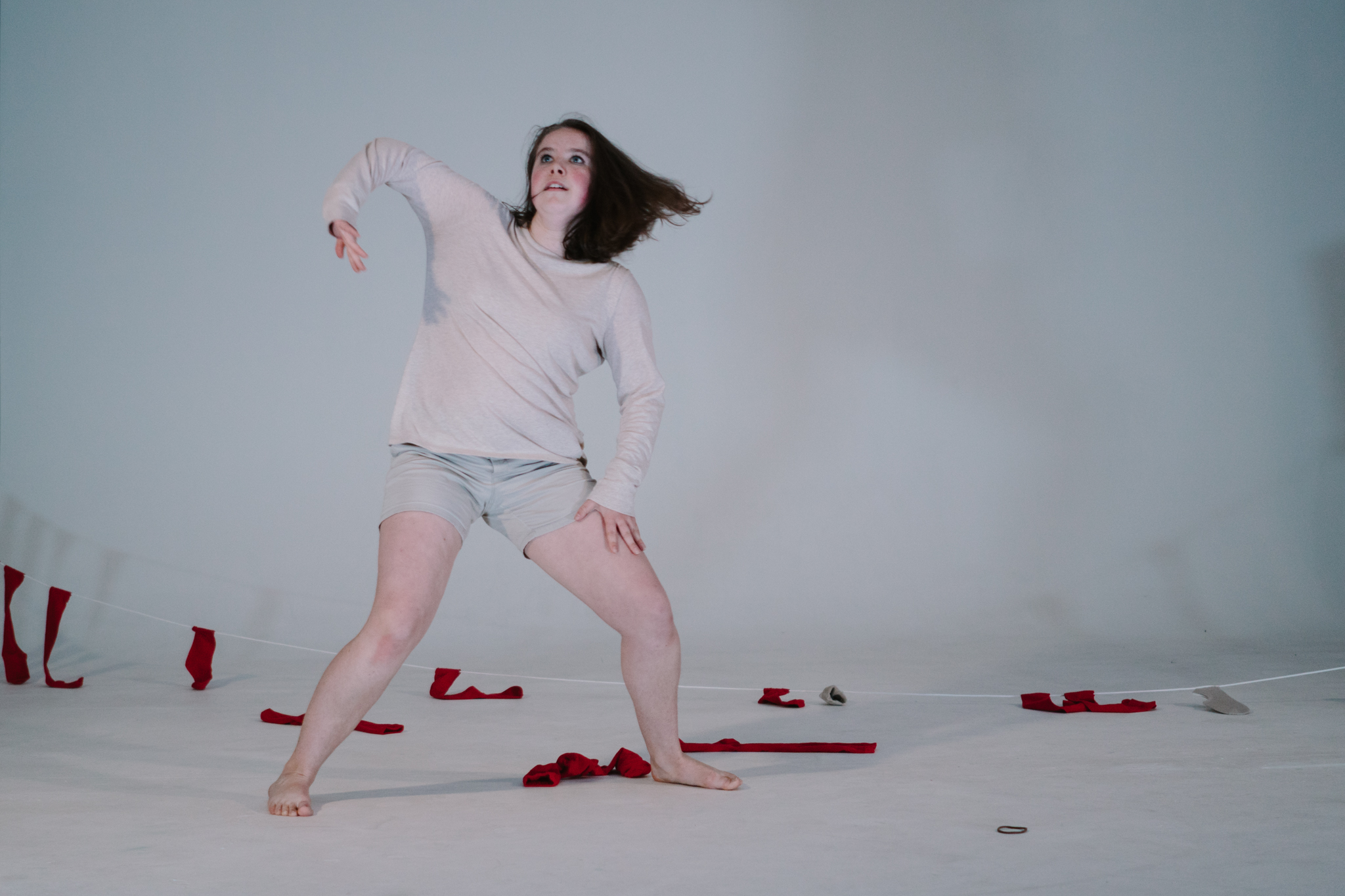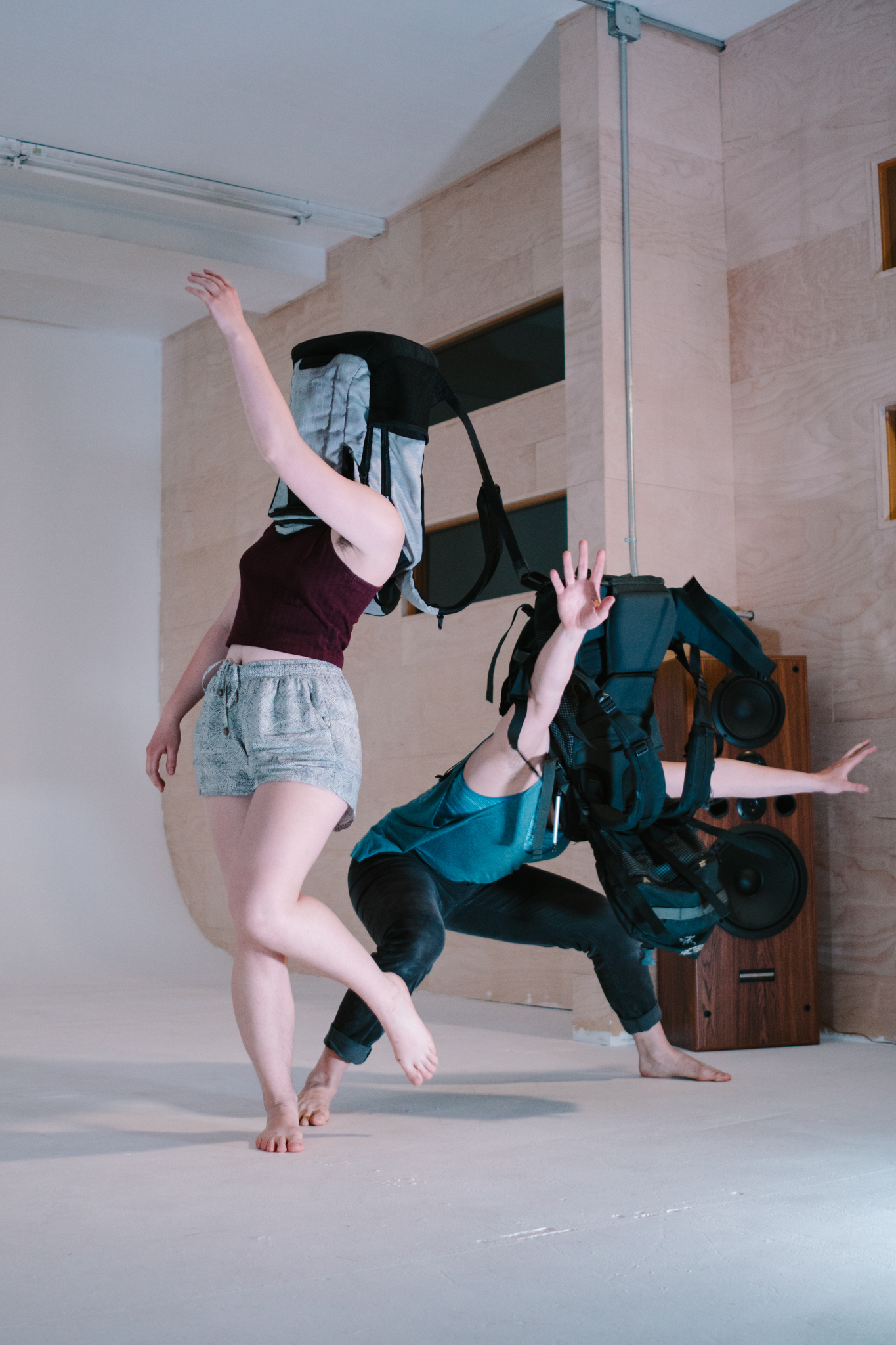The curtain opened on the first evening of Junction Dance Co’s Zero Flux to an empty, yet brightly lit, stage. The audience clapped in anticipation, their excitement palpable. I could tell right off the bat that Junction Dance Co. possesses a loyal fan base, based on the number of catcalls. The music then cut through my thoughts, pulsing. The cyclorama sparked to life, displaying a projection of outer space. Before that image had settled in my mind, the dancers streamed on stage from the wings for the first piece, “New Americana.”
I first noticed the dancers’ tennis shoes. I made a mental note that things to come would require more grip than a bare foot could offer. The music was electric, heightening the effect of the fast and precise dancing. I was impressed by the musicality of the choreography, clearly crafted in tandem with the flux of the music; no note went unaccompanied. The dancers were committed and full of energy, their smiles infectious and genuine even from eight rows back. And I was not disappointed in my assessment of their shoes: I saw lots of tumbling tricks sprinkled with b-boy steaz.
The second piece, “Freedom,” opened with fireworks, both those projected on the cyc and those coming from the five men crushing it with their footwork. I was impressed with their ability to stay in unison even at faster speeds. Women made their way on stage, joining the men in duets. Although each duet used the same phrase, I appreciated that each pair seemed to make the connections on their own.
My favorite moment happened quite drastically: The music changed simultaneously with the cyc. Everything blurred and was pushed suddenly into a new image, that of a city scene. New dancers cascaded into the group, which had now transformed into a street party. Dancers of all ages formed a half moon. Those who stepped into the middle of the semi-circle owned it, grasping their moments in the center. During this cypher session, I took a scan of the audience; I could see some heads bobbing in time to the music. I was glad to see how this piece pulled in the audience, movement now rippling throughout it. “Freedom” exuded a sense of community that truly included everyone.
“Collard Greens” brought out rows of dancers, clad in green, keeping the beat of the music in their feet on a stage also awash with green. The piece was a tap dance, and one of my favorites of the evening in terms of pure enjoyment. Schoolboy Q blared through the speakers (“Oh [oh] luxury / Chidi-ching-ching could buy anything, cop that / Oh [oh] collard greens”) as the dancers mimed money in their hands. Their feet chugged forward, the taps accentuating each beat. The audience went a little wild, whooping with appreciation. I only wished that the music was a little quieter so that I could have heard all of the taps.
In “Peggy Lee,” the dancers sported leotards, tights, and heels. I couldn’t help but think of cabaret clubs, as the movement was sexy and punchy. The playful piece, set to a fresh remix of “Fever,” offered the women a chance to showcase their technique and extensions. I especially enjoyed that the choreography was reminiscent of old jazz rather than sticking to a more contemporary style.
During “Reading Rainbow,” I was transported to a fond memory and delighted by the piece’s lightness. A vibrant rainbow was splashed on the cyc, the backdrop for a single dancer wearing what were possibly the most 80’s-print pants I’ve ever seen. The score was none other than the theme from the TV show “Reading Rainbow.” The soloist perfectly captured a balance between cheesy nostalgia and quirkiness, to a song that defined and nurtured a generation.
“Atomic Breath” felt fully developed. There was a story, guided along by a narration of movie clips; the words lent a framework that shaped the audience’s experience. Different sections that were all tied together took me on a personal journey through a story I created for myself about the birth of the universe and the dawn of time. This dance had many sections of intense movement, the all-male cast fierce in their physicality. “Atomic Breath” was one of the more temporally dynamic works on the program.
“Still,” a solo performed by a dancer sheathed in a powder blue costume, was set to a song conveying failure and heartbreak. The dancer did a great job of holding her own and of letting the lyrics inform her emotional performance, and the piece’s angular, staccato movement suited her. Energetically, though, the piece felt ill-placed on the program. It may have been a better fit next to “Love Journals” in the second half.
“Pursuit of Happiness,” another large group number, featured a lot of unison and relied heavily on formations to fit everyone on the stage. The choreography took on many of the same characteristics as the other dances, and only one moment really stood out to me. All the dancers were on their backs on the floor, and did a ripple in three groups in which they contracted, clawed their fingers, and splayed their legs at weird angles. The lyrics mentioned night terrors and this canon provided a vivid visual.
“Dreamers,” featuring another all-male cast, opened with an image of a hallway, maybe a school, projected on the cyc. A lone dancer in a red jumpsuit entered, sweeping. As he started dancing, other “janitors” wearing the same jumpsuit but carrying different cleaning tools soon joined him onstage. The piece reminded me of all of the times I put on music and jam out, dancing while I’m supposed to be cleaning my house. The piece successfully kept all the dancers onstage doing different tasks while not distracting from the rotating soloists. The music, from the original “Willy Wonka & the Chocolate Factory” with Gene Wilder, created a whimsical setting. The quirkiest solo was by a dancer with a red feather boa who danced to a child’s voice talking. At the end, everyone came together to gather all the feathers that had fallen off the boa, as though they were gathering up their wishes because they now had to go back to work.
“The Quest” was funky and fast. I got lost in the movements and felt like I was at a club or a bumping house party. The songs kept switching and building in intensity. I spotted more canon in the choreography, which was a motif throughout the show. I liked the piece’s abrupt finish, and thought it was a great way stick the ending of the first half.
The second half opened with “Love Journals.” Four women were featured in downpools, frozen as the light shone off of their rose hued, crushed velvet dresses, and moved on musical cues one by one. It was predictable, yet satisfying to watch. The dancers had a lovely sense of timing, each of them aware of the others, and I saw extensions for days that spiraled into attitude jumps. The choreographer here made different choices with timing: They didn’t jam pack movements to accompany every single beat of music. I was actually able to process the movements as the dancers lingered intentionally through their phrases. I appreciated the power of stillness and the purpose of slower movement. I also saw the first bare feet of the evening, which worked well with the concept by allowing the piece to feel more vulnerable.
After the women left the stage, a solo male dancer made his way on. I had seen him performing house tricks and fancy footwork in the other pieces on the program, but in this one he came alive through the contemporary movement, extending and leaping through the air. It was stunning. He was soon joined by another man, the two then performing the same movement but with different facings and spacing. This added a layer of depth, as most other pieces had utilized only front-facing unison. Both also emoted with their faces, making their duet more tender.
“Can you dance to my beat?” featured upbeat music, pops of color on the cyc, and constant motion for the dancers. At times, my focus was pulled to different places as I watched the dancers weave in and out. About halfway through, a drummer entered and began playing in time with the music. I wanted there to be a microphone by his drums, though, so I could hear them better over the loud music. My favorite moment came at the end when a female dancer approached the drummer and the two began creating together as the recorded track came to an end. She was saucy and playful, and he sped up his pace to match her frantic movements. They were very much in it together.
“Positive Vibrations” was performed by the junior Junction Dance Co. group. They were apt performers, showing their growing knowledge of muscular isolation and control. It was easy to see where the name of the work came from as, at different times that matched the music, the women would vibrate their whole bodies. There were also some nice breakout moments from the group, and it was fun to watch an individual dancing versus the group. I was impressed by their ability to lift and partner one another at such a young age.
The standout work was “What Do You Desire?” To begin, a man talked into a microphone, acting out his monologue for two dancers like a teacher lecturing to his students (the dancers were obviously the students as wore costumes resembling school uniforms). There was no music, making it a nice counterpoint to the other pieces. The dancers then performed a duet that visually interpreted the monologue/lecture. The monologue itself highlighted what can be a constant struggle for an artist: Do I make art, or do I eat and pay bills? The dancers made great, and funny, choices - I laughed several times as their movements matched words perfectly. Altogether, the piece was witty and entertaining, and also made me think about what I value.
The dancers in the fun and lively “Slippy Socks” wore gray shirts and shorts with colorful socks. A live violinist provided the score. She felt included in the work as she moved about the stage, smiling and making eye contact with the dancers as she played vigorously. The piece had several duet vignettes in which each dancer matched their partner’s styles and energy well. This piece had a more “modern dance” feel to it, as the choreography blended together big, sweeping circles and dives to the floor and felt gooey rather than sharp or accented.
“How Come?” also featured live music, this time a guitarist who sang and played a sad love ballad that asked why someone wasn’t interested in him. The dancers had perfect timing throughout and looked well-rehearsed.
“Etude No. 2,” a duet between a male dancer and a female pianist, was my favorite of the pieces to live music. The pianist began playing as the dancer held his position on the floor in a meditative position, his eyes closed. The anticipation built until he suddenly began dancing. Each phrase was convoluted and twisting. He tied himself in knots and untangled them, and was up and down, giving a visually dynamic performance. The pianist had her back to the audience, so I could see her fingers flying across the keys (she didn’t look at his dancing). Throughout the piece, he moved closer and closer to the pianist, as if he was being pulled to her inevitably by an unseen force. He ended the same way he began, on the ground with a straight back, knees folded, and eyes closed. As the pianist finished, both turned to look at each other. The lights stayed up to emphasize this powerful moment, and I was struck by the simplicity of their final acknowledgement of the other.
The closing piece, “Earthquake,” was fast and furious like I would expect an earthquake to be. Set to a driving beat that continually sped up, the dance featured the show’s entire cast of performers and packed a punch to conclude the program on a high note.
Overall, I was highly entertained by the evening. Each piece had me tapping my feet because I couldn't help being swayed by the music and movement. The first half felt more planned, with transitions accounted for and dances moving from one piece to the next with no pauses. It also felt more cohesive in content - I could see and make connections between most of the works.
The second half was more random. None of the pieces connected energetically or conceptually. This didn’t necessarily detract, but the sheer number of pieces in the show (nineteen in total) was overwhelming. I found myself wishing that Junction Dance Co. had spent more time developing some pieces, maybe exploring their depth versus just their short aesthetic value. I was, however, impressed with each performer in the show. They were all stunning in their authenticity and performance quality. Not only were they expert performers, but they were (dance) multilingual, performing a variety of styles.
I was reminded that the dance world is constantly evolving. Dancers who can tumble and do tricks are in high demand; they must have the technique, but then also be able to throw it all away. More and more, I see a fusion of styles, with this show being a prime example - a crockpot filled with many ingredients. To extrapolate, I find this evolution within dance to be an apt representation of the fusing of cultures happening all around us.
Ashley Creek is co-director of Brine and can be seen performing with Myriad Dance Company and The Penguin Lady. She also works for Ballet West, teaching Academy students, schoolchildren, and female inmates at the Utah State Prison.









